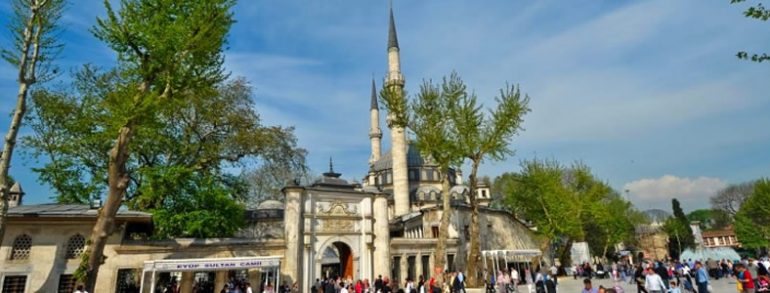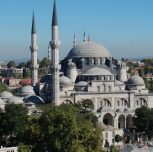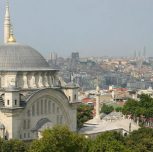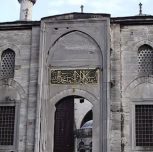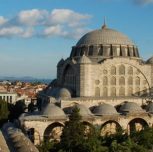The Eyup Sultan Complex, located in the middle of the city, gave its own name to its district It is one of the most prominent complexes experiencing a stream of sightseers visiting Istanbul. The name of the complex comes from Eyüp el-Ensari, a host of the Prophet (pbuh), who participated in pincer movement of Istanbul by the Umayyad army and was martyred in the area of the present mıosque. The construction of the complex was initiated by building a tomb on the location he had already been buried. According to rumors, Akşemseddin, a teacher of Sultan Mehmed II, had a dream in which he saw the place where the blessed person was buried upon which Sultan Mehmed II had initially began building a tomb. The complex, which consists of a mosque, a tomb, a madrasa, (religious school) and a Turkish bath, took its first shape in the year 1459, during which the mosque’s construction began.
The complex has seen numerous changes in its history and has lost its original shape during restoration works. After the earthquake of 1776 and experiencing large scale structural damage, Sultan Selim III (1789-1807) made the decision to tear it down and rebuild it on the same site. The mosque, built by a group of people, of which Uzun Hüseyin Ağa was at the head, was reopened for worship on October 24, 1800 by Sultan Selim III.
The current mosque has substantially different features compared to the original. The main dome of the mosque, built from limestone blocks, measures 17.50 meters in diameter which consists of the ceiling structure of the Harim (sanctum sanctorum) at a size of 26 x 11m. It is supported by two half-domes, each of which has same diameter, and the interior lighting of the mosque is strengthened by window gaps placed on the half domes and the pulley of the central dome. The mosque’s decorations are of an Ottoman Baroque style and are remarkably plain when compared with the predominate, more complex architectural style of the time. There are small fountains, which are known as kısmet çeşmeleri (destitny fountains), located in the middle of the inner court encircled by domed porches. The motifs and architectural elements used on these fountains are made of white marbles, giving a pleasing aesthetic view to them. The mosque has two minarets, each with two shrefes (balconies). Since the minarets were built in the period of Sultan Mehmed II, and were relatively short, both were raised in 1723 by Damat Ibrahim Paşa.
Eyüp Sultan’s tomb, built on an octagonal plan covered by a dome, was built from cut lime stone. Kütahya tiles are used in the inner design of the tomb, and the protective shields crafted out of pure silver by Sultan Selim III and a green pall, a souvenir of Sultan Mahmud II (1785-1839), cover the sarcophagus of Eyüp el-Ensari. Silver sülüs calligraphies, belonging to the calligraphers, Mustafa Rakım Efendi and Sultan Mahmud II, are prominent elements in the inner design of the tomb. As for that the bath of the complex, which was designed as a double bath, is one of the oldest Ottoman baths that continues to stand today.
The madrasa (religious school) and the imaret (soup kitchen) of the mystical complex are the major structures which have not reached our time. In general, the Eyüp Sultan Complex hosts visitiors from every area in Turkey. Due to the spiritual athmosphere of the complex, it is considered a sacred place of pilgrimage for those whose beliefs are strengthened by making its visitors contemplate the afterlife. Furthermore, the number of graves encircling the complex both shows how much the grave owners wished to be buried near Eyüp el-Ensari and illustrates the importance of the city in Islamic Culture.


